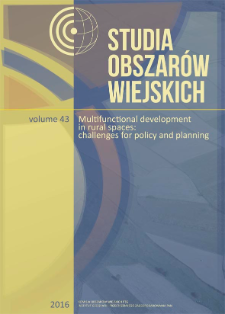
Object
Title: Towards the creation of the “Network of the most interesting villages”. Selected problems of rural renewal in Poland
Subtitle:
Studia Obszarów Wiejskich = Rural Studies, t. 43
Publisher:
Place of publishing:
Description:
Type of object:
Abstract:
Transformations that occur in Polish rural areas also impact tourism and recreation enterprises. Initiation of rural development programmes successfully activates processes of modernisation in many fields of social and economic life, including the material base (infrastructure), which is an essential element in the functioning of settlement systems. The aim of this study is to present selected results of the expert analysis of 50 Polish villages, which are characterised by a high concentration of cultural values – material, institutional and spiritual. The assessment of a group of rural settlements was meant to determine the potential for creating the Network of the Most Interesting Villages. The article presents the factual basis for such evaluation, the differentiation in groups of villages according to selected traits, especially those describing the infrastructural plane for developing the tourism and recreational functions. The recipe for success includes many elements. The most important ones include attractive spatial configuration in which there is no shortage of central locations that are the focus of educational and recreational functions, the social awareness of the value of one’s own heritage and the ability to describe it (the purpose of stay), the existence of long-lasting institutions referring to the historical memory and communal activities, the ability to create the media for narration placed in the internal environment, somewhat-formed path of its own development based on own resources (developed tourism functions), as well as participation in local and regional network of town with varying functions, and natural and anthropogenic environmental values (tourist regions).
References:
1. Idziak W., Wilczyński R., 2013, Odnowa wsi. Przestrzeń, ludzie, działania, FAPA, Warszawa.
2. Kłodziński M., Błąd M., Wilczyński R. (eds.), 2007, Odnowa wsi w integrującej się Europie, IRWiR, Warszawa.
3. Niedźwiedzka-Filipiak I., Wilczyński R., 2015, Walory miejscowości – tworzywem Sieci Najciekawszych Wsi, Marshal's Office of Opolskie Voivodeship, Opole.
4. Staszewska S., 2015, Rola wiedzy środowiskowej mieszkańców w procesie odnowy wsi, Studia Obszarów Wiejskich, 40, pp. 159–167.
https://doi.org/10.7163/SOW.40.11 -
5. Wilczyński R., 2012, Odnowa wsi z wykorzystaniem środków europejskich – niewykorzystana szansa na rewitalizację, Architektura Krajobrazu, Studia i Prezentacje, 2 (35), pp. 4–22.
6. Wilczyński R. (ed.), 2012, Sieć Najpiękniejszych Wsi. Opracowanie eksperckie projektu, PROW, KSOW, Opole.
7. Wójcik M., 2010, Struktura i działanie – geograficzno-społeczna interpretacja oddziaływania funduszy Unii Europejskiej na przykładzie programu Odnowa wsi", Studia Obszarów Wiejskich, 24, pp. 186–201.
Relation:
Volume:
Start page:
End page:
Detailed Resource Type:
Format:
Rozmiar pliku 2,8 MB ; application/pdf
Resource Identifier:
oai:rcin.org.pl:61814 ; 1642-4689 ; 10.7163/SOW.43.4
Source:
CBGiOŚ. IGiPZ PAN, sygn. Cz.4488 ; CBGiOŚ. IGiPZ PAN, sygn. Cz.4489 ; click here to follow the link
Language:
Language of abstract:
Rights:
Licencja Creative Commons Uznanie autorstwa 3.0 Polska
Terms of use:
Digitizing institution:
Instytut Geografii i Przestrzennego Zagospodarowania Polskiej Akademii Nauk
Original in:
Projects co-financed by:
European Union. European Regional Development Fund ; Programme Innovative Economy, 2010-2014, Priority Axis 2. R&D infrastructure
Access:
Object collections:
- Digital Repository of Scientific Institutes > Partners' collections > Institute of Geography and Spatial Organization PAS (IGiPZ PAN) > Publications of IGiPZ PAN and employees
- Digital Repository of Scientific Institutes > Partners' collections > Institute of Geography and Spatial Organization PAS (IGiPZ PAN) > Library > Series/Journals/Periodics
- Digital Repository of Scientific Institutes > Literature > Books/Chapters
Last modified:
Oct 2, 2020
In our library since:
Mar 9, 2017
Number of object content downloads / hits:
1239
All available object's versions:
https://rcin.org.pl./publication/81488
Show description in RDF format:
Show description in RDFa format:
Show description in OAI-PMH format:
Objects Similar
Wójcik, Marcin
Banach, Anna Kozakiewicz, Anna Kozakiewicz, Michał Liro, Anna
Tobiasz-Lis, Paulina Wójcik, Marcin
[Unieski, Aleksander]
Wójcik, Marcin
Wójcik, Marcin
Wolski, Oskar
Jezierska-Biel, Pamela

 INSTYTUT ARCHEOLOGII I ETNOLOGII POLSKIEJ AKADEMII NAUK
INSTYTUT ARCHEOLOGII I ETNOLOGII POLSKIEJ AKADEMII NAUK
 INSTYTUT BADAŃ LITERACKICH POLSKIEJ AKADEMII NAUK
INSTYTUT BADAŃ LITERACKICH POLSKIEJ AKADEMII NAUK
 INSTYTUT BADAWCZY LEŚNICTWA
INSTYTUT BADAWCZY LEŚNICTWA
 INSTYTUT BIOLOGII DOŚWIADCZALNEJ IM. MARCELEGO NENCKIEGO POLSKIEJ AKADEMII NAUK
INSTYTUT BIOLOGII DOŚWIADCZALNEJ IM. MARCELEGO NENCKIEGO POLSKIEJ AKADEMII NAUK
 INSTYTUT BIOLOGII SSAKÓW POLSKIEJ AKADEMII NAUK
INSTYTUT BIOLOGII SSAKÓW POLSKIEJ AKADEMII NAUK
 INSTYTUT CHEMII FIZYCZNEJ PAN
INSTYTUT CHEMII FIZYCZNEJ PAN
 INSTYTUT CHEMII ORGANICZNEJ PAN
INSTYTUT CHEMII ORGANICZNEJ PAN
 INSTYTUT FILOZOFII I SOCJOLOGII PAN
INSTYTUT FILOZOFII I SOCJOLOGII PAN
 INSTYTUT GEOGRAFII I PRZESTRZENNEGO ZAGOSPODAROWANIA PAN
INSTYTUT GEOGRAFII I PRZESTRZENNEGO ZAGOSPODAROWANIA PAN
 INSTYTUT HISTORII im. TADEUSZA MANTEUFFLA POLSKIEJ AKADEMII NAUK
INSTYTUT HISTORII im. TADEUSZA MANTEUFFLA POLSKIEJ AKADEMII NAUK
 INSTYTUT JĘZYKA POLSKIEGO POLSKIEJ AKADEMII NAUK
INSTYTUT JĘZYKA POLSKIEGO POLSKIEJ AKADEMII NAUK
 INSTYTUT MATEMATYCZNY PAN
INSTYTUT MATEMATYCZNY PAN
 INSTYTUT MEDYCYNY DOŚWIADCZALNEJ I KLINICZNEJ IM.MIROSŁAWA MOSSAKOWSKIEGO POLSKIEJ AKADEMII NAUK
INSTYTUT MEDYCYNY DOŚWIADCZALNEJ I KLINICZNEJ IM.MIROSŁAWA MOSSAKOWSKIEGO POLSKIEJ AKADEMII NAUK
 INSTYTUT PODSTAWOWYCH PROBLEMÓW TECHNIKI PAN
INSTYTUT PODSTAWOWYCH PROBLEMÓW TECHNIKI PAN
 INSTYTUT SLAWISTYKI PAN
INSTYTUT SLAWISTYKI PAN
 SIEĆ BADAWCZA ŁUKASIEWICZ - INSTYTUT TECHNOLOGII MATERIAŁÓW ELEKTRONICZNYCH
SIEĆ BADAWCZA ŁUKASIEWICZ - INSTYTUT TECHNOLOGII MATERIAŁÓW ELEKTRONICZNYCH
 MUZEUM I INSTYTUT ZOOLOGII POLSKIEJ AKADEMII NAUK
MUZEUM I INSTYTUT ZOOLOGII POLSKIEJ AKADEMII NAUK
 INSTYTUT BADAŃ SYSTEMOWYCH PAN
INSTYTUT BADAŃ SYSTEMOWYCH PAN
 INSTYTUT BOTANIKI IM. WŁADYSŁAWA SZAFERA POLSKIEJ AKADEMII NAUK
INSTYTUT BOTANIKI IM. WŁADYSŁAWA SZAFERA POLSKIEJ AKADEMII NAUK


































